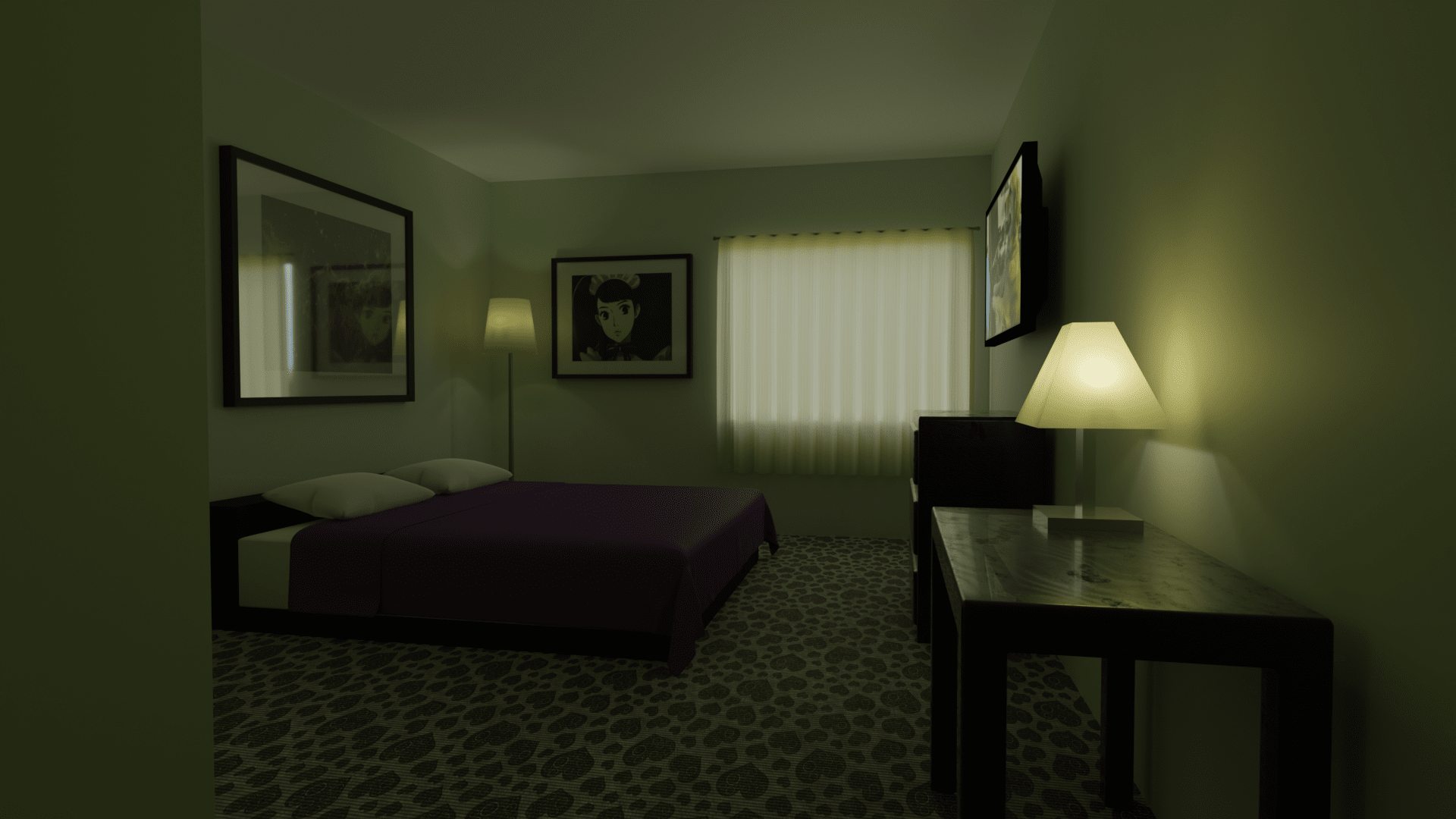You are using an out of date browser. It may not display this or other websites correctly.
You should upgrade or use an alternative browser.
You should upgrade or use an alternative browser.
3D Modelling, Post your 3D models! (Cars, Planes, People, Landscapes etc!)
- Thread starter TheDrummingKING
- 1,343 comments
- 198,673 views
- 1,173

- Australia
So wierd that SMCars is dead since earlier this year. It was the best site for blueprints for anything until 2010s. Other sites just lack content and blueprints are in lower quality.
It's possible that the cat's been let out...
who needs blueprints when CAD models of the part/car you're going to make already exist and are identical to the real thing...
the boom and desire to replicate some car in 3D seems to have died down quite a bit also since games and animations look photorealistic now. It's like all of 3D has been figured out and done now.
where can be CAD files be found? game companies get them from car maker directly and I doubt anyone would release them for free. Also CAD is at least late 70s+ thing. there is reversible engineering (photogrammetry) which also makes blueprints obsolete if actual object to be modeled exists including equipment, and its easier than asking manufacturer for original CAD models.It's possible that the cat's been let out...
who needs blueprints when CAD models of the part/car you're going to make already exist and are identical to the real thing...
the boom and desire to replicate some car in 3D seems to have died down quite a bit also since games and animations look photorealistic now. It's like all of 3D has been figured out and done now.
I agree that classic poly/spline modelling for real objects using blueprints is losing popularity, but someone needs to convert CAD to something usable in game engine or animation. Fictional objects however are not affected by trends. Additionally yes games have growing number of realistic models and modelling professionals (independent or working for modelling studio) simply made and are still making models, pool of available left to scratch make is reducing. Its harder to stand which is discouraging.
I would not be surprised if AI overtake people by 2035 in 3D modelling too
 .
.- 1,173

- Australia
where can be CAD files be found? game companies get them from car maker directly and I doubt anyone would release them for free. Also CAD is at least late 70s+ thing. there is reversible engineering (photogrammetry) which also makes blueprints obsolete if actual object to be modeled exists including equipment, and its easier than asking manufacturer for original CAD models.
I agree that classic poly/spline modelling for real objects using blueprints is losing popularity, but someone needs to convert CAD to something usable in game engine or animation. Fictional objects however are not affected by trends. Additionally yes games have growing number of realistic models and modelling professionals (independent or working for modelling studio) simply made and are still making models, pool of available left to scratch make is reducing. Its harder to stand which is discouraging.
I would not be surprised if AI overtake people by 2035 in 3D modelling too.
I mean all it would take is a few epic leaks from some new hackers on the block... then we'd be mass 3d printing guns at home using pirated CAD models, lol!
IMO 3D modelling is definitely a hobby more than anything now, it will be completely taken over by AI soon enough, but that could be 50+ years away. However maybe some artists can get jobs modelling, I see it still has applications for the mobile and the giant videogame scene especially, so that I see could stick around longer despite the existence of CAD.
Also I think for some time now animated movies has still yet to make the impact the technology deserves, teething issues still there. It can go further. I'm impressed with Netflix's Arcane, and I know that's just barely scratching the surface of what's to come.
Last edited:
3D modelling can still become job from hobby because sometimes mods become official content or companies see talent and propose jobs. 3D modelling is simply changing. Food making didnt die it just became different.IMO 3D modelling is definitely a hobby more than anything now, it will be completely taken over by AI soon enough, but that could be 50+ years away. However maybe some artists can get jobs modelling, I see it still has applications for the mobile and the giant videogame scene especially, so that I see could stick around longer despite the existence of CAD.
Also I think for some time now animated movies has still yet to make the impact the technology deserves, teething issues still there. It can go further. I'm impressed with Netflix's Arcane, and I know that's just barely scratching the surface of what's to come.
- 485

- Croatia
I returned to Blender after a looong time. I was using it before the big redesign so it took a bit of adjustment with the new menus and shortcuts.. anyways I decided to model my guitar to a high standard in terms of modelling, texturing and accuracy. It's nearly done and I'm pretty satisfied.



Proper render:

Colors and textures are not final. What's giving me trouble is that I can't get the strings to wrap around the tuning post correctly - array and bezier curves need to work together and it's a mess.
Proper render:
Colors and textures are not final. What's giving me trouble is that I can't get the strings to wrap around the tuning post correctly - array and bezier curves need to work together and it's a mess.
- 10,917

- Sweden
- eran0004
Looks good!I returned to Blender after a looong time. I was using it before the big redesign so it took a bit of adjustment with the new menus and shortcuts.. anyways I decided to model my guitar to a high standard in terms of modelling, texturing and accuracy. It's nearly done and I'm pretty satisfied.
View attachment 1208795View attachment 1208796View attachment 1208797
Proper render:
View attachment 1208801
Colors and textures are not final. What's giving me trouble is that I can't get the strings to wrap around the tuning post correctly - array and bezier curves need to work together and it's a mess.
For the strings and how they wrap around the tuning post, perhaps you could try to do a physics simulation to generate the shape you need?
- 485

- Croatia
Looks good!
For the strings and how they wrap around the tuning post, perhaps you could try to do a physics simulation to generate the shape you need?
I will look into that thanks. After googling most seem to recommend two methods for my situation:
1. Do the correct shape with a bezier curve and use the array modifier on the string. that doesn't work for me
2. Spin tool seems perfect but i can't get that to work either.
It's something to do with the object origins but I can't figure it out. Upper strings are wound so I had to use actual geometry and not fake it with a texture, which makes bending it to shape manually basically impossible:
- 10,917

- Sweden
- eran0004
Oh, I see what you mean. Yeah, it’s important to have the correct origin for that.I will look into that thanks. After googling most seem to recommend two methods for my situation:
1. Do the correct shape with a bezier curve and use the array modifier on the string. that doesn't work for me
2. Spin tool seems perfect but i can't get that to work either.
It's something to do with the object origins but I can't figure it out. Upper strings are wound so I had to use actual geometry and not fake it with a texture, which makes bending it to shape manually basically impossible:
View attachment 1208822
I've been learning to write this. If I had these tools and resources when I was younger I would have started programming years ago.
EDIT: I just noticed the dithering GTPlanet put on my upload. Since I'm not allergic to pixels, that's a pretty effect!

EDIT: I just noticed the dithering GTPlanet put on my upload. Since I'm not allergic to pixels, that's a pretty effect!

Last edited:
- 26,262

- Houston, Texas, USA
- JMarine25
I have developed a method recently based on studying Magicavoxel voxel models I created. I imported voxel models from Magicavoxel to PLY format. Then, I imported the PLY models into Blender. I later studied the creation of the voxel models while in Blender. I found that the voxel models I exported from Magicavoxel and imported into Blender units is 0.1 each edge. This gave me an idea to make voxel-inspired models. This is a start-to-finish modeling job in Blender. I develop the model cube-by-cube in Blender. Afterwards, I UV map the entire model through the palette approach. In other words, I try to use a set palette or image for which to assign each face a certain place on a UV map. The UV map is a screenshot of the GIMP palette I created (in PNG, of course). This is fairly advanced low-polygon modeling.
There are two dynamics to this method I developed:
* The blocky models I can create can be done from start-to-finish. I just have to imagine what it is I am trying to make and then try to build that model through a series of precise extrusions and duplicating.
* Even though I create a blocky model, I may choose to take the blocky model to serve as a de facto base mesh that I can further refine to develop more interesting models. It would no longer be a "voxel," but I can make them into something not possible through regular voxel modeling.
So basically, this is both voxel modeling and low-level polygon modeling. I'm not doing any scuplting or using overly advanced 3D models. I'm trying to "find my sound" (so to speak) as a 3D modeler, and my "sound" is to go with the blocky aesthetic but in an advanced way. Because I am not an adept or elite 3D modeler, I am perfectly fine working with lower-spec models.
I meant to come up with these images earlier than this post, but here are samples of what I have developed so far:
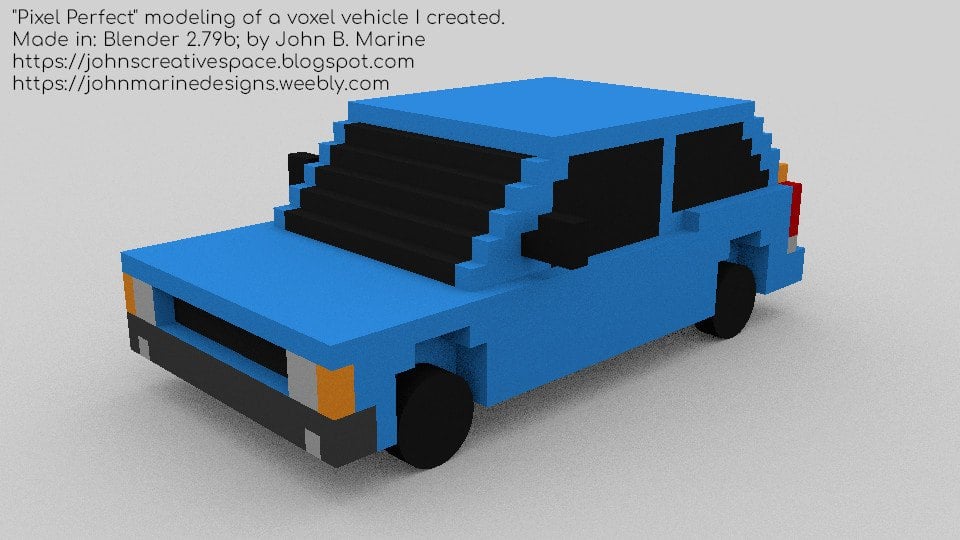
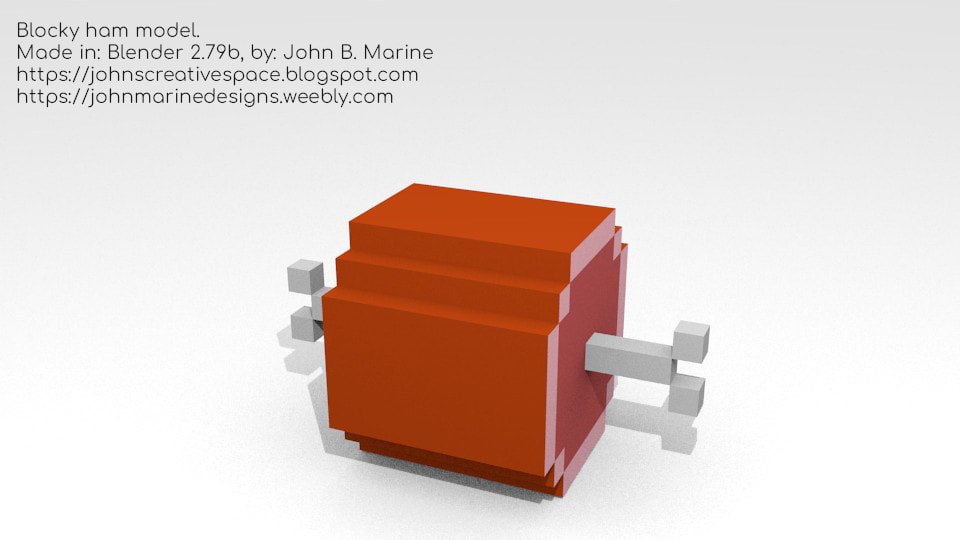
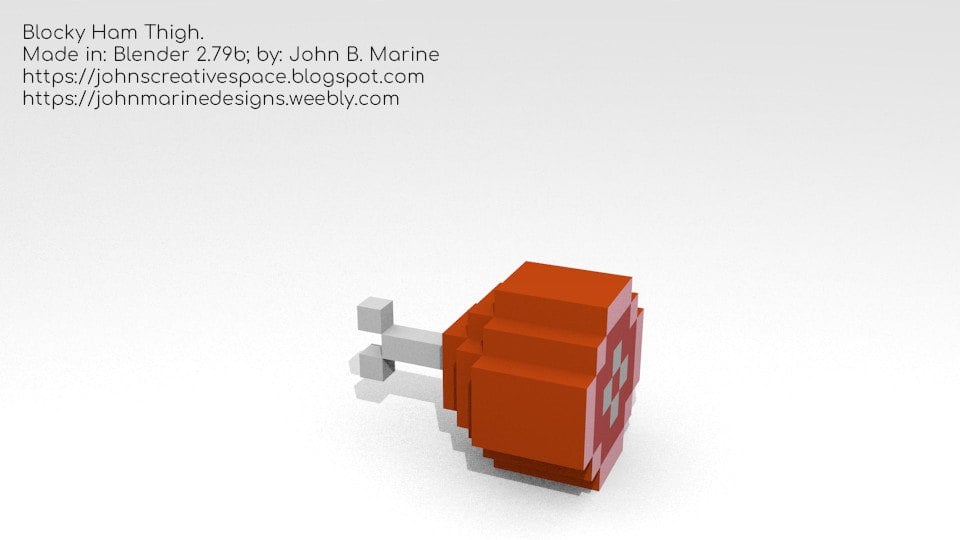
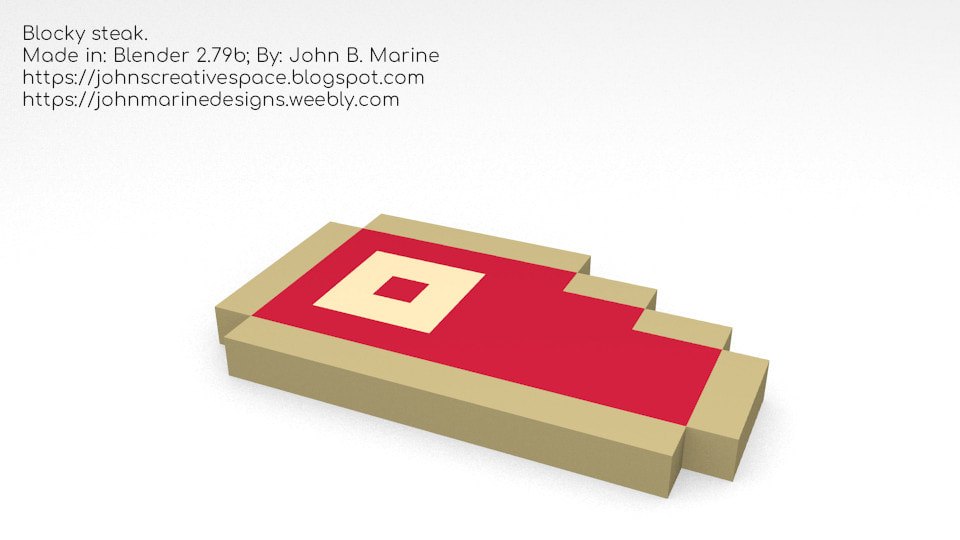
More of my 3D Modeling work
I have many more ideas I want to bring to life, including some I'd like to offer to others. This method may be a pretty fun way to develop more interesting models through the blocky aesthetic. Or of course... using these blocky models as a base mesh for something more refined and can be better refined.
There are two dynamics to this method I developed:
* The blocky models I can create can be done from start-to-finish. I just have to imagine what it is I am trying to make and then try to build that model through a series of precise extrusions and duplicating.
* Even though I create a blocky model, I may choose to take the blocky model to serve as a de facto base mesh that I can further refine to develop more interesting models. It would no longer be a "voxel," but I can make them into something not possible through regular voxel modeling.
So basically, this is both voxel modeling and low-level polygon modeling. I'm not doing any scuplting or using overly advanced 3D models. I'm trying to "find my sound" (so to speak) as a 3D modeler, and my "sound" is to go with the blocky aesthetic but in an advanced way. Because I am not an adept or elite 3D modeler, I am perfectly fine working with lower-spec models.
I meant to come up with these images earlier than this post, but here are samples of what I have developed so far:




More of my 3D Modeling work
I have many more ideas I want to bring to life, including some I'd like to offer to others. This method may be a pretty fun way to develop more interesting models through the blocky aesthetic. Or of course... using these blocky models as a base mesh for something more refined and can be better refined.
- 26,262

- Houston, Texas, USA
- JMarine25
Well, I could have went with some more easy models, but I felt the desire to re-create one of my more complex voxel models. So here is the model I worked on recently:
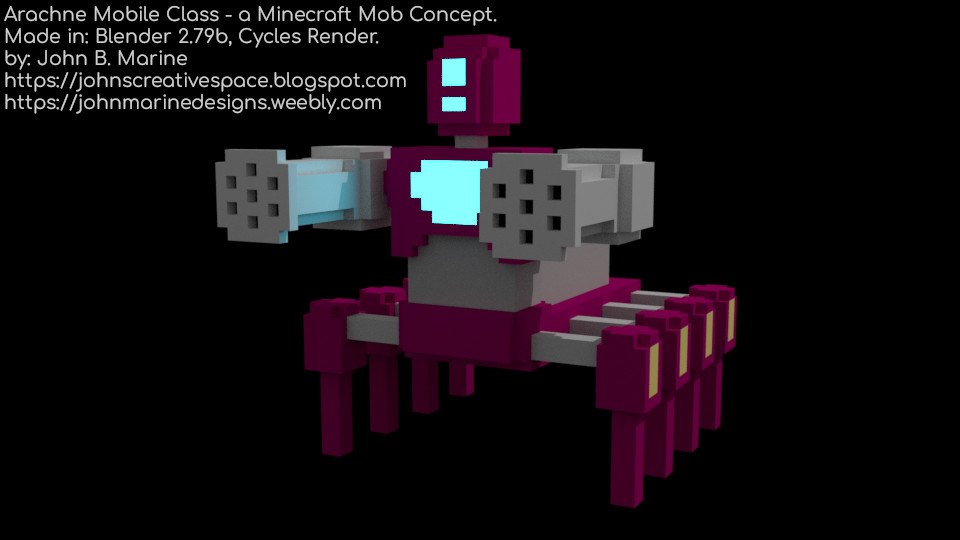
More of my 3D Modeling work
This was originally intended to be a Minecraft Mob I wanted to create. It is called the Arachne Mobile Class mob. This Mob was intended to be a hostile mob. It is armed with two chainguns that can shoot laser ammo. It has lights on its chest, head, and at the back (not visible in this picture). Its height is about two Minecraft blocks high and two Minecraft blocks wide up front. From the sides, it is about three Minecraft blocks long. This model was created cube-by-cube in Blender along with some modifications for render purposes. This re-creation took about two hours to create cube-by-cube, texture, and render. Only thing I didn't do was rig it with an armature, which I had intentions doing. Maybe I'll do that in the future.
Anyhow, yeah. That's my latest 3D modeling creation.

More of my 3D Modeling work
This was originally intended to be a Minecraft Mob I wanted to create. It is called the Arachne Mobile Class mob. This Mob was intended to be a hostile mob. It is armed with two chainguns that can shoot laser ammo. It has lights on its chest, head, and at the back (not visible in this picture). Its height is about two Minecraft blocks high and two Minecraft blocks wide up front. From the sides, it is about three Minecraft blocks long. This model was created cube-by-cube in Blender along with some modifications for render purposes. This re-creation took about two hours to create cube-by-cube, texture, and render. Only thing I didn't do was rig it with an armature, which I had intentions doing. Maybe I'll do that in the future.
Anyhow, yeah. That's my latest 3D modeling creation.
- 1,292

- CZE
- novcze
I mean all it would take is a few epic leaks from some new hackers on the block... then we'd be mass 3d printing guns at home using pirated CAD models, lol!
IMO 3D modelling is definitely a hobby more than anything now, it will be completely taken over by AI soon enough, but that could be 50+ years away. However maybe some artists can get jobs modelling, I see it still has applications for the mobile and the giant videogame scene especially, so that I see could stick around longer despite the existence of CAD.
Also I think for some time now animated movies has still yet to make the impact the technology deserves, teething issues still there. It can go further. I'm impressed with Netflix's Arcane, and I know that's just barely scratching the surface of what's to come.
...speaking of videogames, did anyone here try Dreams on PlayStation 4/5, it's also a hobby, nothing serious, but it goes beyond 3D modelling as you can animate and basically make a game.
Things I did can be found here https://indreams.me/novcze
e.g.
- 1,173

- Australia
...speaking of videogames, did anyone here try Dreams on PlayStation 4/5, it's also a hobby, nothing serious, but it goes beyond 3D modelling as you can animate and basically make a game.
Things I did can be found here https://indreams.me/novcze
e.g.
Dreams is fantastic. I stopped playing the game mostly because Whilst I like being creative, I ended up being too disorganised with my creations and therefore they all fell short, to make the most of dreams I'd have to take it quite seriously and label everything, which for me detracts the whole point of it being a game! But I often enjoy the many creations that the community comes up with. I've seen a lot of impressive vehicle physics sandboxes, but only wish most were turned into games, that does take a lot of work though so I can see why many dreams are mostly impressive tech demos
- 1,292

- CZE
- novcze
yeah, creating something decent in Dreams is like second work and not many have that much free time.Dreams is fantastic. I stopped playing the game mostly because Whilst I like being creative, I ended up being too disorganised with my creations and therefore they all fell short, to make the most of dreams I'd have to take it quite seriously and label everything, which for me detracts the whole point of it being a game! But I often enjoy the many creations that the community comes up with. I've seen a lot of impressive vehicle physics sandboxes, but only wish most were turned into games, that does take a lot of work though so I can see why many dreams are mostly impressive tech demos
- 26,262

- Houston, Texas, USA
- JMarine25
I tried more practice of the mesh plane tiling method to build scenes. With some basic drawing in GIMP, I set up a texture atlas to be imported into Blender. The scene consisted of a 64x64 PNG file that I imported into Blender with the Images as Planes feature. I later scaled up the plane 4x and subdivided it into 4x4 sections. Each tile is 1 meter length-wise and height-wise.
I felt like developing a scene I thought could be used for a game or some sort of media project. Because I turned my focus to low-spec art and low-spec modeling, everything looks basic. I originally went with mesh planes 2 meters in length, but I went with 1 because I envisioned this as a Minecraft world. Since one Minecraft block is 1 meter length, width, and height; I used that to envision the perespective I wanted to capture. Here is the scene:
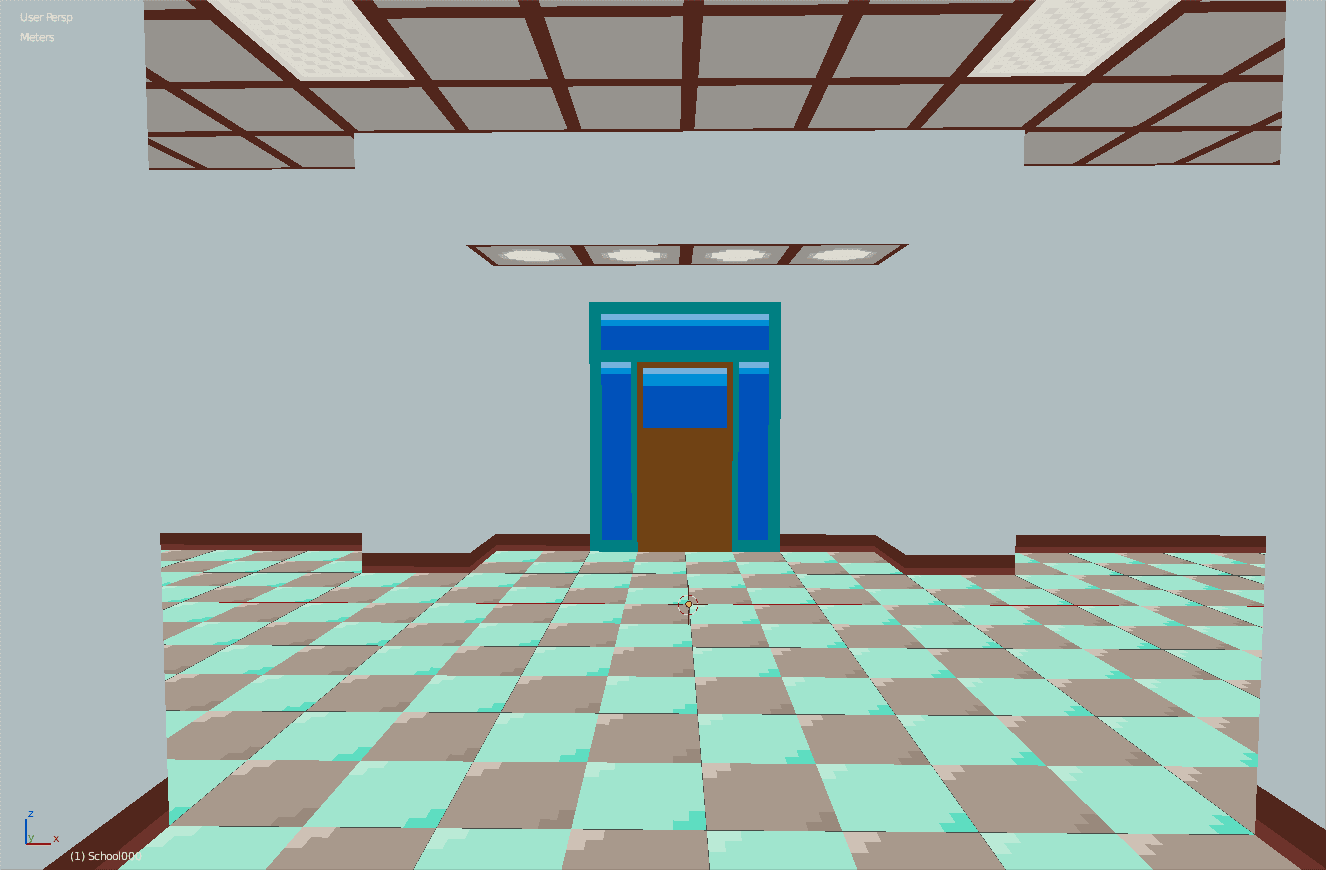
^ (Source: My X/Twitter)
This scene is supposed to be a High School with the Principal's Office in view. If I was thinking of making a full-blown scene that can be captured from any angle, I may decide to make my own full setting and really give any possible media project makers something to use and enjoy.
I am thinking about making more scenes in the future. So if I do that or come up with something else good, I'll share my work with you all.
I felt like developing a scene I thought could be used for a game or some sort of media project. Because I turned my focus to low-spec art and low-spec modeling, everything looks basic. I originally went with mesh planes 2 meters in length, but I went with 1 because I envisioned this as a Minecraft world. Since one Minecraft block is 1 meter length, width, and height; I used that to envision the perespective I wanted to capture. Here is the scene:

^ (Source: My X/Twitter)
This scene is supposed to be a High School with the Principal's Office in view. If I was thinking of making a full-blown scene that can be captured from any angle, I may decide to make my own full setting and really give any possible media project makers something to use and enjoy.
I am thinking about making more scenes in the future. So if I do that or come up with something else good, I'll share my work with you all.
- 26,262

- Houston, Texas, USA
- JMarine25
My evolved low-polygon character model vision is becoming clearer! Here is a low-polygon, low-spec model I developed over this weekend:

This prototype is what I hope can be used for media projects and games based on my voxel characters I've created. I tried different 3D mesh modifications to test its versatility. The arms, legs, and head are separated. I designed this model to have a six-bone armature setup, like a Minecraft player model or a ROBLOX R6 model. I want to evolve it further to make it a 15-bone armature setup (like ROBLOX R15 models). That means separating the arms and legs into two parts. Also, I want to add some hands and feet, also separated.
This model began life as a 64x64 image as plane imported into Blender. I subdivided it until each pixel was its own cell of the mesh grid. I later took each piece and "folded" each part until it became body parts I eventually put together. I later modified the edges, faces, and UVs to something interesting. What I want to do is keep it all the same but use a larger image size to fill in each piece with details. It is all basically making something simple simple, but also enhancing its appeal.
I'll keep working on it. This is what I have for now.
This prototype is what I hope can be used for media projects and games based on my voxel characters I've created. I tried different 3D mesh modifications to test its versatility. The arms, legs, and head are separated. I designed this model to have a six-bone armature setup, like a Minecraft player model or a ROBLOX R6 model. I want to evolve it further to make it a 15-bone armature setup (like ROBLOX R15 models). That means separating the arms and legs into two parts. Also, I want to add some hands and feet, also separated.
This model began life as a 64x64 image as plane imported into Blender. I subdivided it until each pixel was its own cell of the mesh grid. I later took each piece and "folded" each part until it became body parts I eventually put together. I later modified the edges, faces, and UVs to something interesting. What I want to do is keep it all the same but use a larger image size to fill in each piece with details. It is all basically making something simple simple, but also enhancing its appeal.
I'll keep working on it. This is what I have for now.
- 26,262

- Houston, Texas, USA
- JMarine25
Lately, I have been developing low-polygon, low-spec 3D models. This is all in my move towards lower-style 3D modeling after so much trouble trying to be high-resolution. Once I learned how to implement 3D models into game ports, it fueled my interest into developing more content for these games. I am using GZDOOM for 3D in classic DOOM, and I am using JFDuke3D for Duke Nukem 3D. I am using a combination of Blender [4.0.1] and Noesis 3D to produce my 3D models into games. A collection of what I have developed so far can be seen in the collage below:

^ Source: My X/Twitter (@johnbmarine)
I use Blender to develop models and export them to FBX; then, I use Noesis to convert my FBX files to the MD2 or MD3 3D model format. I have to use certain parameters for the FBX exports to work properly porting into Noesis. I set "Forward" to -X and the "up" direction to +Y. I also triangulate all faces. MD2 is the older one used in a lot of different games, but it was mostly used for "Quake 2." MD3 is most used for "Quake 3 Arena" and is better for animation than MD2. It is also used for most models in the freeware first-person shooter, "Cube 2 Sauerbraten." "Cube 2 Sauerbraten," though, also utilizes some MD5 models.
As of yet, I have not attempted complex models or animated/rigged models. It took me ages to finally implement a model into Duke Nukem 3D using the High Resolution Pack (HRP). I eventually found out since my models don't have a named keyframe, I have to leave the animation frame blank for them to show up in DN3D. This has been the workflow that has been kindest to me for GZDOOM and JFDuke3D. Once I get to animated models, I will have to learn to not only implement animations but also get them to work in the games I import my work to.
This is all nothing special 3D-wise. However, this is part of my move towards being more low-spec and almost pixel art 3D.

^ Source: My X/Twitter (@johnbmarine)
I use Blender to develop models and export them to FBX; then, I use Noesis to convert my FBX files to the MD2 or MD3 3D model format. I have to use certain parameters for the FBX exports to work properly porting into Noesis. I set "Forward" to -X and the "up" direction to +Y. I also triangulate all faces. MD2 is the older one used in a lot of different games, but it was mostly used for "Quake 2." MD3 is most used for "Quake 3 Arena" and is better for animation than MD2. It is also used for most models in the freeware first-person shooter, "Cube 2 Sauerbraten." "Cube 2 Sauerbraten," though, also utilizes some MD5 models.
As of yet, I have not attempted complex models or animated/rigged models. It took me ages to finally implement a model into Duke Nukem 3D using the High Resolution Pack (HRP). I eventually found out since my models don't have a named keyframe, I have to leave the animation frame blank for them to show up in DN3D. This has been the workflow that has been kindest to me for GZDOOM and JFDuke3D. Once I get to animated models, I will have to learn to not only implement animations but also get them to work in the games I import my work to.
This is all nothing special 3D-wise. However, this is part of my move towards being more low-spec and almost pixel art 3D.
- 26,262

- Houston, Texas, USA
- JMarine25
PERSONAL HISTORY MADE! For the first time ever, I made an animated 3D model and imported into a game! This proof-of-concept model just swings its arms. This was animation practice replacing DOOM's Soulsphere powerup. Next TO DO: refine animations...

From: (X/Twitter)
The point of this post is that I learned how to make a simple 3D animation and implement it into a game. While this is not a proper model or a demonstration of my 3D talent, the point of this was to develop an animated 3D model and put it into a game with the animations intact. This is something I've never done before until tonight. I'm accomplished!

From: (X/Twitter)
The point of this post is that I learned how to make a simple 3D animation and implement it into a game. While this is not a proper model or a demonstration of my 3D talent, the point of this was to develop an animated 3D model and put it into a game with the animations intact. This is something I've never done before until tonight. I'm accomplished!
- 1,173

- Australia
Great progress! I find as long as you're comfortable to practice at it then you can be consistent in producing new content and trying new things etc. End result doesn't matter so much as the will to practice consistently, the results follow in timePERSONAL HISTORY MADE! For the first time ever, I made an animated 3D model and imported into a game! This proof-of-concept model just swings its arms. This was animation practice replacing DOOM's Soulsphere powerup. Next TO DO: refine animations...

From: (X/Twitter)
The point of this post is that I learned how to make a simple 3D animation and implement it into a game. While this is not a proper model or a demonstration of my 3D talent, the point of this was to develop an animated 3D model and put it into a game with the animations intact. This is something I've never done before until tonight. I'm accomplished!
Last edited:
- 26,262

- Houston, Texas, USA
- JMarine25
I wanted to try doing low-spec pixel art to downsize my 3D art efforts. I never exceled at making realistic 3D; or at least, 3D art that can be seen as "acceptable" to most people. I figure my calling is to try to design 3D art and textures with my own identity. Because I am someone who is about bare essentials instead of making something overly flashy and beautiful, I am slowly moving towards downsizing my work.
What I did recently was design a race track inspired by an Adobe Flash game called "Moja Grand Prix." This game used some very low-spec graphics and textures for design of these 3D tracks. The game had some pseudo 3d sprites (nowadays "billboards") and some basic 3D with the walls, signs, overlays, and grandstands. The point was to design low-spec graphics for a model. A quick map I designed in about 10-20 minutes is what you see below:
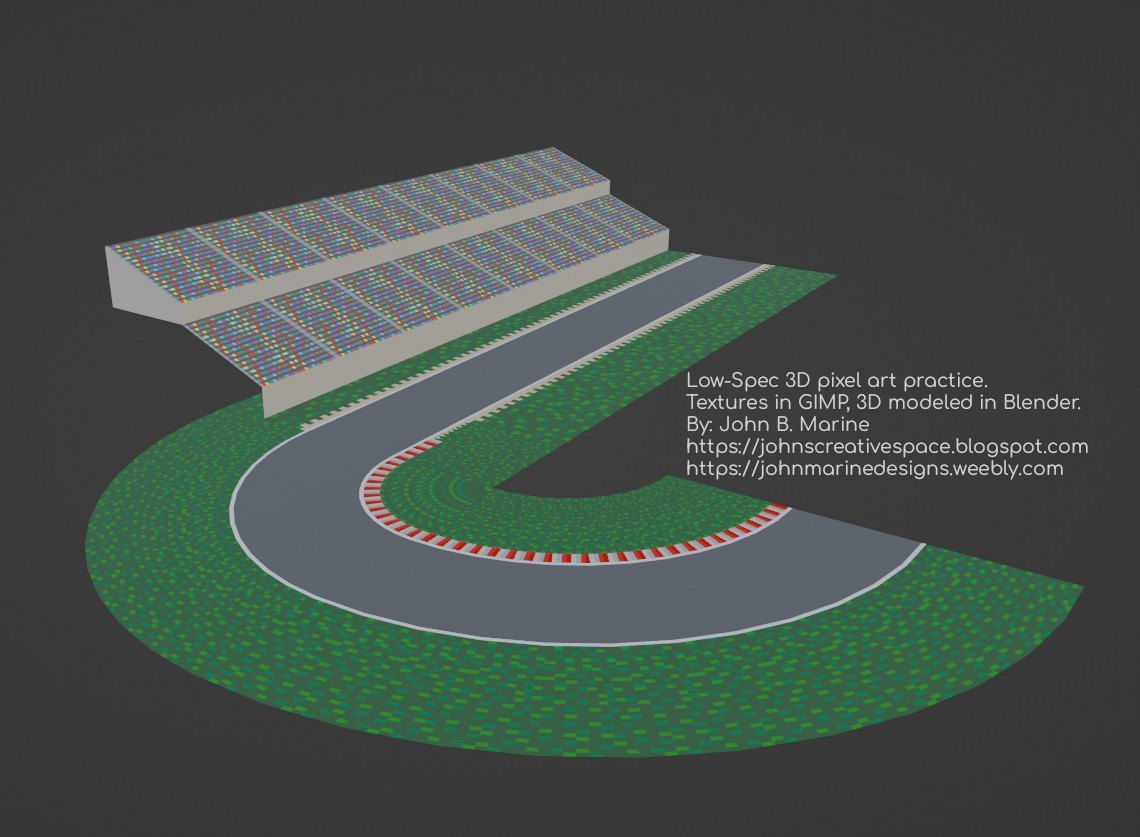
^ Source: My X/Twitter ( @johnbmarine )
While this is not going to win any awards for most beautiful track, it is certainly a better effort than a lot of low-quality models I've seen on certain 3D retailers like Turbosquid. If I were to test it, I'd use my vehicle controllers in Unity3D or program these tracks into Assetto Corsa. I actually intend on making these track models available for games and game engines. I prefer doing mostly original courses. I feel like I wouldn't do real locations justice or respect if I were to 3d model real-world places. So to limit would-be damage, I'm doing my own thing.
One of my inspirations is to design low-spec material as if Mode 7 games were given a more 3D facelift. While not making things hyper-realistic or photo-realistic, I am somewhat trying to balance old-style 3D with a few modern tricks while keeping everything fairly classic. I'm even studying Super Nintendo and Game Boy Advance games that use 3D style modeling for its environments. These will not be impressive 3D models and maps, but I feel I can make low-spec cool. That is even if I want fancy pants, modern, simulation racing games to take advantage of my work. I'm actually serious on making low-spec cool for racing games of the arcade, "simcade," and pure sim variety. If we have (for example) a LEGO race track and Mario Kart series tracks for Assetto Corsa, I can make my own low-spec and low-resolution work to be just as cool as the fancy stuff.
I used a texture atlas for this sample run rather than separate textures. I had to learn how to re-map UV mapping when using the Spin tool. The Spin tool is the most effective way to model curves for race tracks. I once made a practice race track for Assetto Corsa that had elevation changes. I found it was best to bevel the top and bottom of elevation changes to ensure smooth movement when going uphill or downhill. Adding about five segments of beveling spread decently enough will make elevation changes not as sloppy (unless you want sloppy elevation changes). A texture atlas can be effective if you're trying not to have so many smaller images for textures. I seen some of the older mod tracks I had for old Sports Car GT (and a few vehicle mods for SCGT as well) used texture atlases instead of individual bitmaps for textures. However, it can be a bit messy to designate certain faces to one specific part of the texture in a texture atlas.
My original idea was to use a large texture of 1024x1024 or 2048x2048 to design the track, and then subdivide the Image as Plane down to 16x16 tiles. I then would refine the geometry to include 3D models and elevation changes. It was a cool idea, but I feel it would be rather tedious. So I went with a different method. This method was a variation of trying to make Mode 7-style maps to have greater 3D depth. The idea of using a completed race track texture map was inspired by the likes of Super Mario Kart, Wacky Wheels, Skunny Kart, and even the original Turbo Sliders.
Thanks for reading my breakdown of my latest 3D work. Keep on modelin'!
What I did recently was design a race track inspired by an Adobe Flash game called "Moja Grand Prix." This game used some very low-spec graphics and textures for design of these 3D tracks. The game had some pseudo 3d sprites (nowadays "billboards") and some basic 3D with the walls, signs, overlays, and grandstands. The point was to design low-spec graphics for a model. A quick map I designed in about 10-20 minutes is what you see below:

^ Source: My X/Twitter ( @johnbmarine )
While this is not going to win any awards for most beautiful track, it is certainly a better effort than a lot of low-quality models I've seen on certain 3D retailers like Turbosquid. If I were to test it, I'd use my vehicle controllers in Unity3D or program these tracks into Assetto Corsa. I actually intend on making these track models available for games and game engines. I prefer doing mostly original courses. I feel like I wouldn't do real locations justice or respect if I were to 3d model real-world places. So to limit would-be damage, I'm doing my own thing.
One of my inspirations is to design low-spec material as if Mode 7 games were given a more 3D facelift. While not making things hyper-realistic or photo-realistic, I am somewhat trying to balance old-style 3D with a few modern tricks while keeping everything fairly classic. I'm even studying Super Nintendo and Game Boy Advance games that use 3D style modeling for its environments. These will not be impressive 3D models and maps, but I feel I can make low-spec cool. That is even if I want fancy pants, modern, simulation racing games to take advantage of my work. I'm actually serious on making low-spec cool for racing games of the arcade, "simcade," and pure sim variety. If we have (for example) a LEGO race track and Mario Kart series tracks for Assetto Corsa, I can make my own low-spec and low-resolution work to be just as cool as the fancy stuff.
I used a texture atlas for this sample run rather than separate textures. I had to learn how to re-map UV mapping when using the Spin tool. The Spin tool is the most effective way to model curves for race tracks. I once made a practice race track for Assetto Corsa that had elevation changes. I found it was best to bevel the top and bottom of elevation changes to ensure smooth movement when going uphill or downhill. Adding about five segments of beveling spread decently enough will make elevation changes not as sloppy (unless you want sloppy elevation changes). A texture atlas can be effective if you're trying not to have so many smaller images for textures. I seen some of the older mod tracks I had for old Sports Car GT (and a few vehicle mods for SCGT as well) used texture atlases instead of individual bitmaps for textures. However, it can be a bit messy to designate certain faces to one specific part of the texture in a texture atlas.
My original idea was to use a large texture of 1024x1024 or 2048x2048 to design the track, and then subdivide the Image as Plane down to 16x16 tiles. I then would refine the geometry to include 3D models and elevation changes. It was a cool idea, but I feel it would be rather tedious. So I went with a different method. This method was a variation of trying to make Mode 7-style maps to have greater 3D depth. The idea of using a completed race track texture map was inspired by the likes of Super Mario Kart, Wacky Wheels, Skunny Kart, and even the original Turbo Sliders.
Thanks for reading my breakdown of my latest 3D work. Keep on modelin'!


